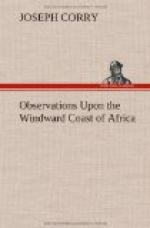To the Africans, the indispensible articles of life are reduced to a very narrow compass, and they are unacquainted with the insatiate wants of Europeans. The heat of the climate renders cloathing an incumberance, and occasions a carelessness with regard to their dwellings: for the former, they require only a stripe of linen, and their gris-gris; while a building of mud, covered with an interwoven and thatched roof, forms the latter, which is reared with little labour, and, when circumstances require it, is abandoned without much regret.
The food of the Negro consists chiefly of rice, millet, &c. seasoned with palm oil, butter, or the juices of the cocoa-nut tree mixed with herbs of various kinds. They frequently regale themselves with other dishes, kous-kous, and country mess, to which they sometimes add fowls, fish, and flesh, heightened in the flavour by a variety of savory applications.
A contracted system of agriculture, conducted by their women and slaves, in a very few days prepares the lugars, or cultivated fields; and the harvest is distributed by the elders of the community, according to the portion and wants of the society of the village, or is stored up to be portioned out as circumstances may require.
Water is the ordinary drink of the Negroes; they, however, regale themselves with a wine extracted from the palm tree, as before described, which, in the luxury of indulgence, they frequently suck through a very small kind of cane, until inebriety and stupidity absorb them in a perfect state of apathy. They have also a very pleasant beverage, extracted from the cocoa nut and banana tree, besides several descriptions of beer, fermented from various roots and herbs. In the Rio Pongo, and adjacent countries, especially in the Bashia branch of that river, the Soosees extract a fermented and intoxicating liquor from a root growing in great abundance, which they call gingingey, something similar to the sweet potatoe in the West Indies. The distillation is commenced by forming a pit in the earth, into which a large quantity of the root is put, and covered with fuel, which is set on fire, and kept burning until the roots are completely roasted: the roots are then put into paloons, and beat, exposed afterwards in mats to the sun, by which they acquire a taste similar to honey; and are afterwards put into hampers for distillation. This is performed by making a funnel of sticks in a conical form, interwoven together like basket-work; the funnel is filled with the material, and water poured upon it; the succulent moisture therefrom passes through a tube, and yields a liquid similar in colour to coffee, and of a violent purgative quality. It remains in this state about twenty-four hours, and is then incorporated with a quantity of the ashes of rice-straw, which excites a bubbling fermentation like boiling water, after which it becomes fit for use. In forty-eight hours it returns again to its purgative state, which interval is employed in drinking most copiously, until overtaken by insensibility and intoxication. The root, in its roasted state, is an excellent medicine for colds.




